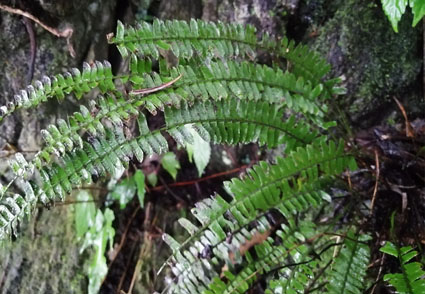Abstract
A new fern species, Polystichum jinpingense, a member of P. subg. Haplopolystichum sect. Haplopolystichum, is described and illustrated from southeastern Yunnan, China. Polystichum jinpingense is most similar to P. subacutidens in plant size and having numerous pinnae, but the former has thinner (0.7–0.9 mm in diam.) rachis, oblong pinnae, pinna margins undulate, and pinna apex cuspidate, whereas the latter has thicker (1.1–1.4 mm in diam.) rachis, triangular pinnae, pinna margins serrate, and pinna apex acuminate. Polystichum jinpingense has an extremely narrow distribution and is classified as Critically Endangered (CR) following IUCN Red List Criteria.
References
<p>Han, M.-Q., Liu, Y. & Zhang, L.-B. (2018) Eight new species of <em>Polystichum</em> (subg. <em>Haplopolystichum</em>; Dryopteridaceae) from limestone caves in Guangdong and Yunnan, China, with reference to species diversity in the karst terrains at high elevations in subtropical areas. <em>Phytotaxa</em> 365: 145–168. https://doi.org/10.11646/phytotaxa.365.2.3</p>
<p>IUCN. (2017) The IUCN Red List of Threatened Species. Version 2017-1. Available from: www.iucnredlist.org (accessed 10 March 2022)</p>
<p>Kung, H.-S., Chu, W.-M., He, Z.-R. & Zhang, L.-B. (2001) <em>Polystichum</em>. <em>In: </em>Kung, H.-S. (Ed.) <em>Flora Reipublicae Popularis Sinicae</em>. vol. 5 (2). Beijing, Science Press. pp. 1–246.</p>
<p>Li, X.-W. (1996) Floristic statistics and analyses of seed plants from China. <em>Acta Botanica Yunnanica</em> 18: 363–384.</p>
<p>Lu, N.T., Zhang, L. & Zhang, L.-B. (2014) Ten new records of <em>Polystichum</em> (Dryopteridaceae) for Vietnam and lectotypification of <em>Polystichum atroviridissimum </em>and<em> P. fimbriatum</em>. <em>Phytotaxa</em> 164: 115–123. https://doi.org/10.11646/phytotaxa.164.2.5</p>
<p>Roth, A.W. (1800) <em>Tentamen Florae Germanicae</em>, vol. 3. Gleditsch, Leipzig, 578 pp.</p>
<p>Tagawa, M. (1940) <em>Polystichum</em> of Japan, Korea, and Formosa I. <em>Acta Phytotaxonomica Geobotanica </em>9: 119–138.</p>
<p>Wu, S.-G., Xiang, J.-Y. & Pan, K.-L. (2005) Some new records of ferns from Vietnam (1). <em>Acta Botanica Yunnnanica</em> 27: 249–252.</p>
<p>Wu, S.-G., Xiang, J.-Y. & Pan, K.-L. (2006) Some new records of ferns from Vietnam (2). <em>Acta Botanica Yunnnanica</em> 28: 17–18. https://doi.org/10.3724/SP.J.1143.2012.11100</p>
<p>Wu, S.-G., Xiang, J.-Y., Pan, K.-L. & Souliya, O. (2012) Some new records of ferns from Vietnam and Laos (3) <em>Pteris</em> (Pteridaceae). <em>Plant Diversity & Resources</em> 28: 17–18.</p>
<p>Xiang, L.-L. (1994) A taxonomic study on the <em>Polystichum</em> sect. <em>Holopolystichum</em> from Yunnan. <em>Acta Phytotaxonomica Sinica</em> 32: 258–267.</p>
<p>Zhang, L.-B. & Barrington, D.S. (2013) <em>Polystichum</em>.<em> In: </em>Wu, Z.-Y., Raven, P.H. & Hong, D.-Y. (Eds.) <em>Flora of China</em>, vols. 2–3. Science Press, Beijing & Missouri Botanical Garden Press, St. Louis, pp. 629–713.</p>
<p>Zhang, M.-G., Zhou, Z.-K., Chen, W.-Y., Slik, J.W.F., Cannon, C.H. & Raes, N. (2012) Using species distribution modeling to improve conservation and land use planning of Yunnan, China. <em>Biological Conservation</em> 153: 257–264. https://doi.org/10.1016/j.biocon.2012.04.023</p>


